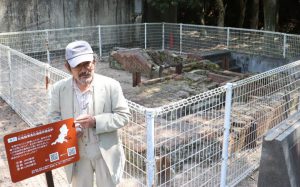Hiroshima City installs 25 signboards explaining war remains on Ninoshima Island, hoping visitors learn deeply
Jun. 20, 2024
by Michio Shimotaka, Staff Writer
The City of Hiroshima has created signboards explaining the war-related remains from the Sino-Japanese War to the Pacific War scattered around Ninoshima Island in the city’s Minami Ward. The city hopes visitors to the island will use the signboards when walking around the island, helping spread the information about the island’s history.
The signboards were placed at a total of 25 locations including sites of the former ammunition depot and internment camp. They contain explanatory texts and quizzes, and by scanning a QR code with a smartphone, users can read the correct answers and detailed explanations. For example, at the site of the former army equine quarantine station incinerator within the Juchheim Ninoshima Welcome Center and Outdoor Activity Camp, a signboard states people who died in the atomic bombing were cremated there.
After 2020, island residents established the Ninoshima History volunteer Guide association and opened the Ninoshima Peace Museum. However, as guides are not always available to assist visitors, Minami Ward installed the signboards this spring.
Kazuo Miyazaki, 76, president of the guide association who supervised the signboards, said, “August 6, 1945 didn’t come suddenly. In order to learn why it happened, I want visitors to know about the history of Ninoshima Island, which is connected to the history of Hiroshima and Japan.”
(Originally published on June 20, 2024)
The City of Hiroshima has created signboards explaining the war-related remains from the Sino-Japanese War to the Pacific War scattered around Ninoshima Island in the city’s Minami Ward. The city hopes visitors to the island will use the signboards when walking around the island, helping spread the information about the island’s history.
The signboards were placed at a total of 25 locations including sites of the former ammunition depot and internment camp. They contain explanatory texts and quizzes, and by scanning a QR code with a smartphone, users can read the correct answers and detailed explanations. For example, at the site of the former army equine quarantine station incinerator within the Juchheim Ninoshima Welcome Center and Outdoor Activity Camp, a signboard states people who died in the atomic bombing were cremated there.
After 2020, island residents established the Ninoshima History volunteer Guide association and opened the Ninoshima Peace Museum. However, as guides are not always available to assist visitors, Minami Ward installed the signboards this spring.
Kazuo Miyazaki, 76, president of the guide association who supervised the signboards, said, “August 6, 1945 didn’t come suddenly. In order to learn why it happened, I want visitors to know about the history of Ninoshima Island, which is connected to the history of Hiroshima and Japan.”
(Originally published on June 20, 2024)








